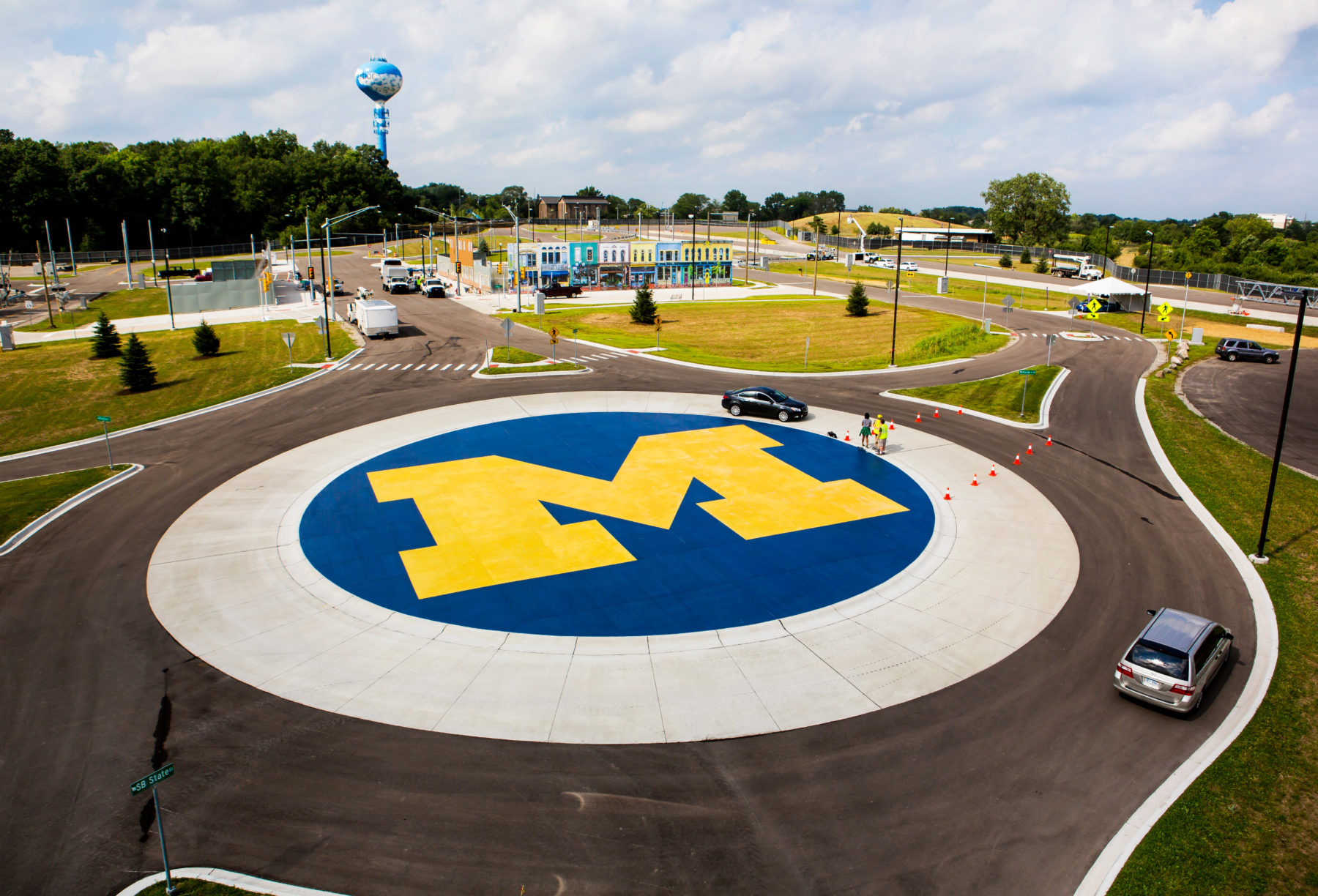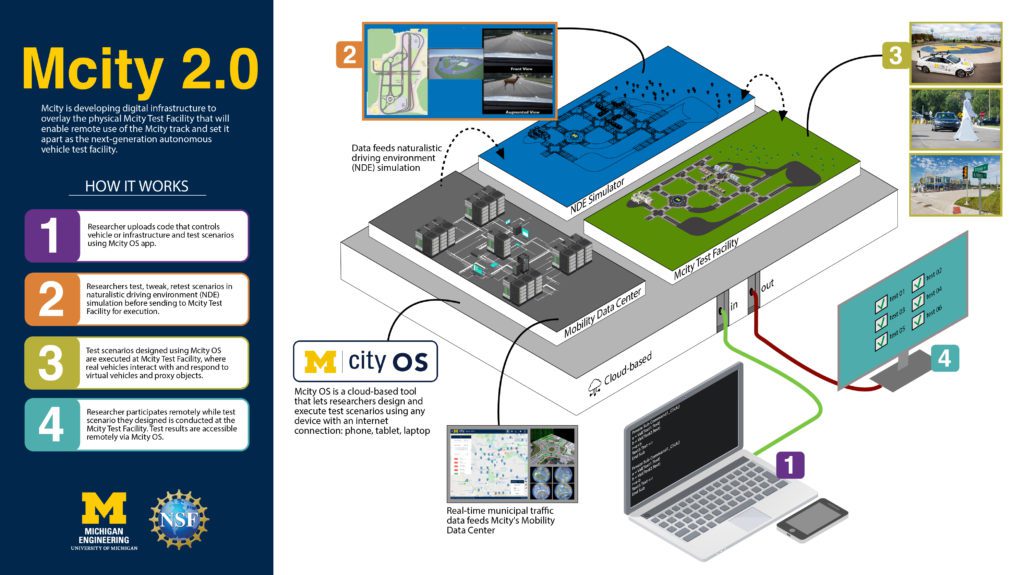$5.1 million NSF award to enable next-generation AV testing at Mcity

“Mcity 2.0” will give researchers, many without testing resources, remote access to the Mcity Test Facility—creating a more equitable playing field in mobility.
ANN ARBOR—Mcity, which operates the world’s first purpose-built test environment for connected and autonomous vehicles (AVs), will invest $5.1 million from the National Science Foundation to supercharge the facility’s evolution into a test track unlike any other.
By enhancing its physical testing environment, adding virtual reality software and generating real-world datasets, Mcity can provide tailor-made simulation scenarios for AV software testing. It’s a new chapter for Mcity, the public-private mobility research partnership led by the University of Michigan, designed to increase access to AV testing resources while accelerating the adoption of new mobility technologies.
“The new digital infrastructure combining real-world data sets with high-quality simulation capabilities and a physical test track will set Mcity apart from other AV test facilities, and enable remote use.
Henry Liu, Mcity Director
Available for public use, Mcity 2.0 will be especially valuable for academic researchers and institutions without their own test facilities and vehicles. U.S.-based researchers can send their algorithms and programs to Mcity, plug them into the facility’s operating system, request specific conditions for testing and participate remotely as those parameters play out in Mcity’s combined real/virtual setting.

“The new digital infrastructure combining real-world data sets with high-quality simulation capabilities and a physical test track will set Mcity apart from other AV test facilities, and enable remote use,” said Henry Liu, director of both Mcity and the Center for Connected and Automated Transportation, a regional transportation research center funded by the U.S. Department of Transportation, and a professor of civil and environmental engineering.
“The proliferation of AVs and connected vehicles will create a safer travel environment,” Liu said, “and by making this next generation version of Mcity available to a wider range of researchers, we believe we can help accelerate adoption.”
This investment will increase access to the state-of-the-art test facility, providing more equity to researchers across the globe who are on the forefront of this societal shift, navigating the transition to a new world of safer, greener, more equitable, and accessible mobility for all.
Alec D. Gallimore, Robert J. Vlasic Dean of Engineering
Research efforts in the AV arena can be hindered by a lack of access: access to real-world data, to high-quality simulation environments and to physical testing facilities. By overlaying digital infrastructure on physical infrastructure, Mcity can provide all three.
“Since its launch in 2015, Mcity has solidified the University of Michigan as a global leader in driving the future of mobility,” said Alec D. Gallimore, the Robert J. Vlasic Dean of Engineering. “This investment will increase access to the state-of-the-art test facility, providing more equity to researchers across the globe who are on the forefront of this societal shift, navigating the transition to a new world of safer, greener, more equitable, and accessible mobility for all.”
Real world data sets that support Mcity simulations are collected from select smart intersections in Ann Arbor and Detroit, with more intersections to be equipped. Each intersection is fitted with privacy-preserving sensors to capture the motion of everything from cars to pedestrians, categorizing each road user and identifying its speed and direction. That information can be instantaneously sent to connected vehicles in the vicinity, triggering onboard warnings when cars are in dangerous situations. Mcity partners on these projects.
“NSF invests in a broad array of fundamental research and new technologies for smart transportation, ranging from semiconductors and microelectronics to wireless communication, contactless electric vehicle charging, and artificial intelligence. Testing these vehicle technologies in real-world scenarios is an essential step for transferring innovations to businesses, communities, and drivers.
Susan Margulies, assistant director for Engineering, national science foundation
The University of Michigan Transportation Research Institute (UMTRI), where Liu is also a research professor, has been collecting this kind of data—between vehicles and the surrounding environments—for a decade through the “living laboratory” of the Ann Arbor Connected Vehicle Test Environment and its predecessor Safety Pilot Model Deployment. At its peak, nearly 3,000 vehicles were involved, making it the largest connected vehicle deployment in the world. These projects provided evidence that connected vehicles have the potential to significantly reduce crashes where driver impairment is not a factor by 80 percent.
Earlier this year, U-M completed a $1.5 million upgrade to a building on the Mcity Test Facility site that will be used to monitor testing. The structure once housed the traffic control center for a test track built by Bendix in 1971 for research on early driverless vehicles.
Mcity’s evolution is the latest addition to U-M’s expanding portfolio of research projects tied to the future of mobility. In July, the State of Michigan approved a budget that included $130 million for a new EV center led by Michigan Engineering. And U-M is already home to the Walter E. Lay Auto Lab and UMTRI, and is a founding partner of the American Center for Mobility in Ypsilanti.
“NSF invests in a broad array of fundamental research and new technologies for smart transportation, ranging from semiconductors and microelectronics to wireless communication, contactless electric vehicle charging, and artificial intelligence,” said Susan Margulies, NSF assistant director for Engineering. “Testing these vehicle technologies in real-world scenarios is an essential step for transferring innovations to businesses, communities, and drivers.”
Gallimore is also the Richard F. and Eleanor A. Towner Professor, an Arthur F. Thurnau Professor and a professor of aerospace engineering.
This story was written by Jim Lynch of Michigan Engineering.